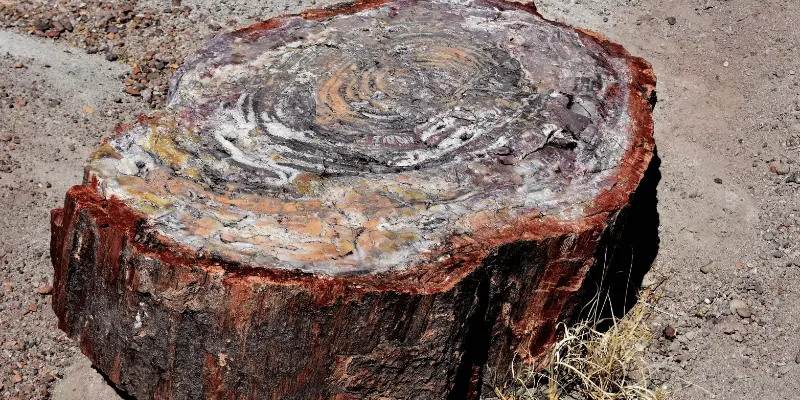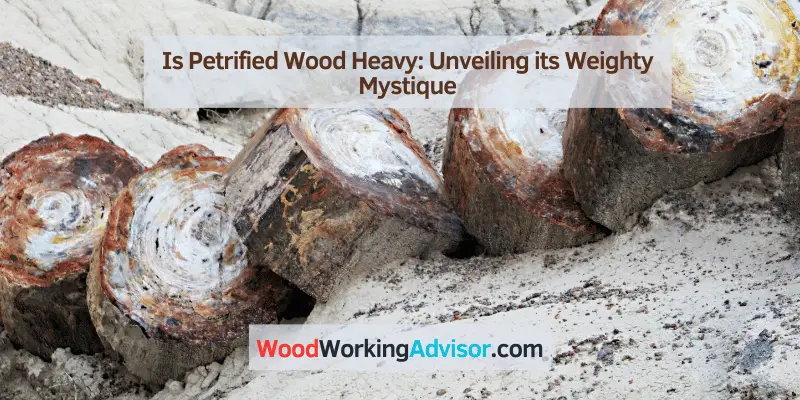Yes, petrified wood is heavy due to the process of fossilization. Over time, the organic material in wood is replaced by minerals, making it denser and heavier.
Petrified wood can weigh anywhere from 150 to 200 pounds per cubic foot, depending on the specific minerals it has absorbed. This weight and density make it valuable for various purposes, such as construction, decorative items, and jewelry. Petrified wood is prized for its unique look and durability, making it a sought-after material for both collectors and artisans.
Its weightiness adds to its appeal and versatility in different applications. Understanding the properties and characteristics of petrified wood can enhance appreciation for its value and significance in various industries and disciplines.
Weighty Mystique Of Petrified Wood
Petrified wood is a fascinating natural wonder that captivates the imagination. Its weighty nature adds to its allure, evoking a sense of ancient strength and resilience. But is petrified wood heavy? Let’s delve into the density, factors contributing to its weight, and the impact of the petrification process on its wood weight.
Comparison To Regular Wood Density
When comparing the density of petrified wood to regular wood, the difference is striking. Petrified wood typically has a much higher density than its original organic form. The process of petrification, where organic material is replaced with minerals, results in a significant increase in weight.
Factors Contributing To Petrified Wood Heaviness
The exceptional heaviness of petrified wood can be attributed to several factors. One of the key contributors is the replacement of organic matter with minerals such as silica, quartz, and carbonates. This mineralization process results in a substantial increase in weight, transforming the once-light wood into a dense and weighty material.
Impact Of Petrification Process On Wood Weight
The petrification process is a transformative journey for wood, leading to a remarkable impact on its weight. As organic matter is gradually replaced by minerals, the petrified wood becomes increasingly dense, resulting in a substantial weight gain. This metamorphosis from organic wood to petrified wood imbues the material with a remarkable heft, adding to its enduring mystique and appeal.

Material Transformation Explained
Petrified wood is a fascinating natural wonder that holds the history of Earth’s ancient forests. Understanding the process of petrifaction sheds light on the intricate transformation of wood into stone. From the geological conditions required for wood petrification to the timescale of this remarkable process and the mineral exchange involved, uncovering the material transformation behind petrified wood reveals the incredible forces at play.
Geological Conditions For Wood Petrification
The petrification of wood occurs under specific geological conditions. When a fallen tree is rapidly buried by sediment, it becomes isolated from decay-causing agents such as oxygen and microorganisms. This burial needs to occur in an environment with an absence of oxygen to prevent the wood from decomposing. Over time, the organic material begins to absorb minerals from the surrounding groundwater, leading to the gradual replacement of wood tissues with minerals.
Timescale Of Wood Turning To Stone
The transformation of wood into petrified wood occurs over an extended period, typically taking millions of years. This process involves the slow but continuous mineralization of the organic structure. As minerals, mainly silica, seep into the cellular structure of the wood, they effectively replicate the original plant material, resulting in the formation of a stony, fossilized replica of the once-living tree. The slow pace of this transformation ensures the preservation of intricate details, including grain patterns and growth rings, in the petrified wood.
Mineral Exchange During Petrification
During petrifaction, an intricate mineral exchange takes place within the cellular structure of the wood. The original plant material is gradually replaced by minerals, primarily silica, but also including elements like iron, manganese, and carbon. This exchange occurs at a minute scale, with the mineral-rich water permeating the wood and depositing minerals that crystallize within the cellular voids. This process results in the preservation of the wood’s texture and structure even as it transitions into a heavy, stone-like material.
Petrified Wood Heavy Attributes
Delving into the world of petrified wood, one might wonder about its weight. Is petrified wood heavy? Well, the answer varies depending on several factors such as its size, type, and level of petrification. Let’s explore the heavy attributes of petrified wood and understand the average weight, variability by wood type and petrification, and how to estimate its weight through visual and physical clues.
Average Weight Of Petrified Wood Pieces
The average weight of petrified wood varies depending on its size and density. Generally, a small piece of petrified wood may weigh only a few pounds, while larger pieces can weigh several hundred pounds. The weight of petrified wood is influenced by its mineral content, which contributes to its density and overall mass.
Variability In Weight By Wood Type And Petrification
The weight of petrified wood can vary greatly based on the type of wood and the extent of its petrification. Hardwood species typically produce heavier petrified wood due to their dense nature, while softer woods may result in lighter petrified wood. Additionally, the level of petrification, which determines the degree of mineral replacement, can also influence the weight of the wood. Fully petrified pieces tend to be heavier than those with partial petrification.
How To Estimate The Weight: Visual And Physical Clues
Estimating the weight of petrified wood can be done through visual and physical clues. By examining the size and density of the piece, one can make a rough estimation of its weight. Additionally, physically lifting and gauging the heft of the wood can provide insights into its weight. However, for more accurate measurements, the use of a scale or balance is recommended to determine the precise weight of petrified wood.
Assessing Petrified Wood In Nature
Petrified wood is a remarkable natural phenomenon that occurs when organic wood material gradually transforms into stone through a process called mineralization. When exploring nature for petrified wood, there are important considerations to keep in mind, including ideal conditions for finding it, techniques for handling and transporting it safely, and case studies comparing its weight in various locations.
Ideal Conditions For Finding Petrified Wood
- Look for areas with volcanic activity, as this can increase the likelihood of finding petrified wood.
- Search in dry, arid regions where wood is less likely to decompose and more likely to undergo the petrification process.
- Check riverbeds and eroded slopes where petrified wood may have been exposed over time.
Techniques For Handling And Transporting Petrified Wood Safely
- Use padding and protective equipment to avoid chipping or damaging the petrified wood during transportation.
- Avoid dropping or mishandling petrified wood, as it can be fragile despite its stone-like appearance.
Case Studies: Comparing Petrified Wood Weight In Various Locations
| Location | Weight (in pounds) |
|---|---|
| Arizona | 20 |
| Wyoming | 30 |
| Utah | 25 |
Practical Tips For Petrified Wood Lovers
For petrified wood enthusiasts, handling and displaying these beautiful specimens can be an exciting yet challenging task. Petrified wood is often heavy and delicate, requiring careful consideration and practical tips for its safe handling and display. Whether you’re a collector or simply want to incorporate petrified wood into your home decor, these guidelines, creative display ideas, and safety considerations will help you make the most of your petrified wood treasures.
Guidelines For Lifting And Moving Petrified Wood
When it comes to handling heavy petrified wood, following proper guidelines for lifting and moving is crucial to prevent damage to the specimen and ensure your safety. Consider the following tips:
- Assess the weight: Before lifting, assess the weight of the petrified wood to determine if you need assistance or specialized equipment.
- Use proper lifting techniques: When lifting heavy petrified wood, bend at the knees, keep your back straight, and use your leg muscles to lift the object.
- Use lifting aids: If the petrified wood is exceptionally heavy, consider using lifting straps, dollies, or other specialized equipment to move it safely.
Creative Display Ideas For Heavy Petrified Wood
Once you’ve successfully moved your petrified wood, it’s time to showcase its natural beauty in a creative and visually appealing manner. Consider the following display ideas for heavy petrified wood:
- Custom stands: Create custom stands or install sturdy shelves to support the weight of the petrified wood and display it at eye level for maximum impact.
- Accent lighting: Incorporate accent lighting to highlight the unique patterns and colors of the petrified wood, adding a captivating visual element to your display.
- Grouping and arrangement: Arrange multiple pieces of petrified wood in a visually appealing composition, creating a stunning focal point in any room.
Safety Considerations For Public And Private Displays
When showcasing petrified wood in public or private settings, it’s essential to prioritize safety to prevent accidents and preserve the specimens for future enjoyment. Consider the following safety considerations:
- Secure installations: Ensure that petrified wood displays are securely installed to prevent toppling or shifting, especially in high-traffic areas.
- Proper signage: If displaying petrified wood in a public setting, provide clear signage to inform visitors about the weight and fragility of the specimens, encouraging respectful viewing.
- Routine inspections: Regularly inspect the display area to check for any signs of wear, damage, or instability, addressing any issues promptly.
Frequently Asked Questions On Is Petrified Wood Heavy
How Can You Tell If Its Petrified Wood?
You can tell if it’s petrified wood by examining the texture and weight. Look for wood grain patterns preserved in rock and tap for a solid, heavy sound.
How Much Does A Petrified Log Weigh?
A petrified log can weigh anywhere from a few pounds to several tons, depending on its size and composition. The weight varies based on the specific type of wood and the level of mineralization.
Does Petrified Wood Break Easily?
Yes, petrified wood is quite durable and does not break easily. It has undergone a process that has replaced the organic material with minerals, making it hard and resistant to breaking.
How Many Years Does It Take To Petrify Wood?
It typically takes millions of years for wood to petrify into stone through a process called mineral replacement.
Conclusion
Petrified wood is heavy due to its mineral content. Understanding its weight helps in identifying and handling these unique fossils. Knowing the weight of petrified wood can enhance the appreciation of its natural history and the processes that led to its formation.
Explore and learn about petrified wood to gain a deeper understanding of this fascinating natural material.



2 thoughts on “Is Petrified Wood Heavy: Unveiling its Weighty Mystique”